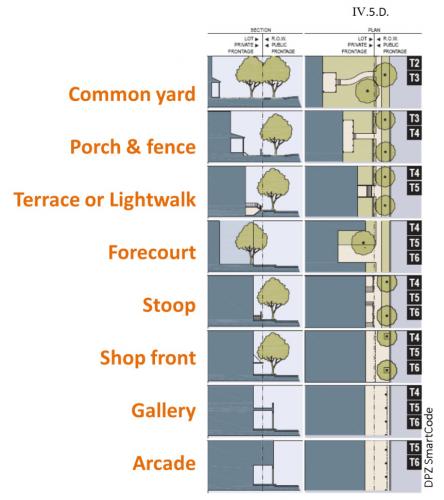Putting up a good front
More than a place to park, frontages of structures play a key role in community character and walkability.
The way that a building addresses the street is much more important than having an address on the street and parking in front. Streets and public spaces are the foundations of community character and the way buildings frame and interact with that space is a key component of creating a working pedestrian-friendly space. Unfortunately, modern suburban development has given little thought to this interaction between building and public space. This practice has led to greater separation between public and privates spaces and a decline in community character. In residential areas, the primary feature fronting the street has become the garage and driveway, which is essentially turning our back to the street. In commercial areas, the primary feature is a parking lot. Not only does this adversely affect the character, it affects the viability and function of the private spaces.
Building frontages serve to frame the public space and create the enclosure (or public room) where social interaction takes place. Correct enclosure creates a pedestrian-friendly space and regulates traffic speed. It is this public room that creates community character and building frontage sets the tone as a ‘wall’ framing the space. In a traditional residential area, structures have small front yards with porches or stoops attached to the front. This creates a social interaction area allowing for people to converse and observe the street. This semi-private space creates safety and character. In traditional commercial areas, the building sits at the sidewalk, framing the space, and creating a visually interesting environment. This framed space creates a public room for social and economic activity. Frontages and thoroughfares should be scaled together to create a pedestrian-friendly space. The ratio between building height and distance from frontage to frontage in most locations should ideally be 1:1 and not exceed 1:2 or twice as wide as tall. Beyond a ratio of 1:3 enclosure properties are lost and the sensation of comfort diminishes.
The interaction of a structure with the public space, or frontage, can be classified into eight basic categories. These frontage types define character and the type of interaction between private and public space. The diagram below shows these eight frontages as they intensify from suburban to urban core. Common yard, and porch and fence are typical frontages seen in most suburban neighborhoods, and a stoop would be its urban equivalent. Shop front, arcade, and gallery are commercial frontages are typically seen in urban areas.

Frontage and enclosure are key aspects in form that lead to creating a sense of place. Done correctly, they create places people want to gather and interact. Done poorly, they create places people dread to go. These types of standards can be coded into local ordinances to help create vibrant places. For more information on form and place contact a Michigan State University Extension Land Use Educator or visit Miplace.org.



 Print
Print Email
Email

